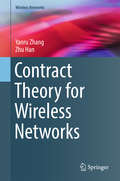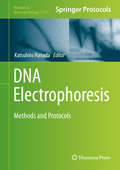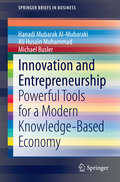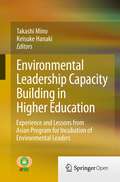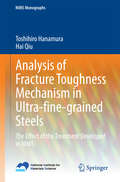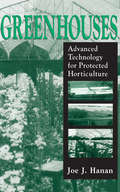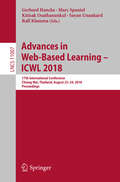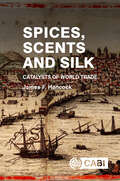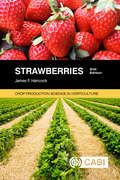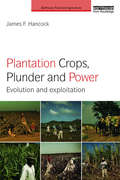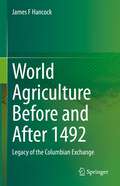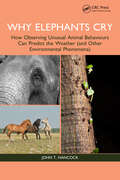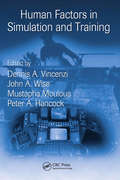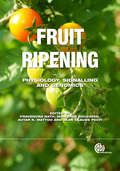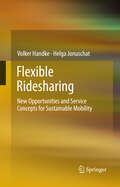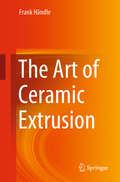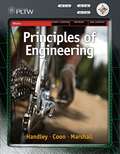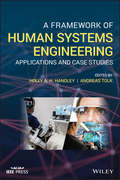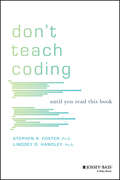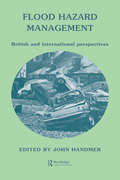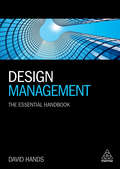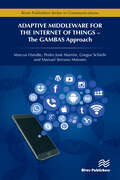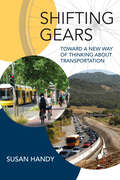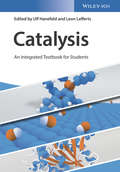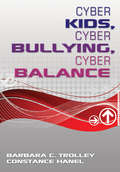- Table View
- List View
Contract Theory for Wireless Networks (Wireless Networks)
by Zhu Han Yanru ZhangThis book presents theoretical research between wireless communications, networking, and economics using the framework of contract theory. This work fills a void in the literature by closely combining contract theoretical approaches with wireless networks design problems. Topics covered include classification in contract theory, reward design, adverse selection, and moral hazard. The authors also explore incentive mechanisms for device-to-device communication in cellular networks, insurance plans for service assurance in cloud computing markets with incomplete information, multi-dimensional incentive mechanisms and tournament based incentive mechanisms in mobile crowdsourcing. Financial applications include financing contracts with adverse selection for spectrum trading in cognitive radio networks and complementary investment of infrastructure and service providers in wireless network visualization. This book offers a useful reference for engineers and researchers in the wireless communication community who seek to integrate the notions from contract theory and wireless engineering, while emphasizing on how contract theory can be applied in wireless networks. It is also suitable for advanced-level students studying information systems or communications engineering.
DNA Electrophoresis: Methods and Protocols (Methods in Molecular Biology #2119)
by Katsuhiro HanadaThis volume explores the latest techniques used by researchers to study DNA electrophoresis, with focus on various species including bacteria, yeasts, and mammalian cells. The chapters in this book cover topics such as two-dimensional gel electrophoresis; DNA replication; pulsed-field gel electrophoresis; ChIP; and post-labeling/PAGE method for detection of DNA adducts. Written in the highly successful Methods in Molecular Biology series format, chapters include introductions to their respective topics, lists of the necessary materials and reagents, step-by-step, readily reproducible laboratory protocols, and tips on troubleshooting and avoiding known pitfalls.Cutting-edge and authoritative, DNA Electrophoresis: Methods and Protocols is a valuable resource for any researchers looking to learn more about this developing field.
Innovation and Entrepreneurship
by Hanadi Mubarak Al-Mubaraki Ali Husain Muhammad Michael BuslerIn this book, Hanadi Mubarak, Ali Husain and Michael promote the concept of innovation incubators from a business-management perspective. The book provides a comprehensive roadmap for the development of new economies based on technology, as well as value added in technology transfer, innovation development and an entrepreneurial climate. Many books on innovation and entrepreneurship take a theoretical approach, presenting a selection of examples that may not reflect reality. However, this compendium of innovation and entrepreneurship case studies is based on the practical experience of executives and managers regarding the undertaking of projects within their industry and company. It is this practical approach, emphasizing enterprise-wide projects as a consequence of the current economic reality that differentiates this book from conventional texts on innovation and entrepreneurship. This investigation uses successful international case studies based on models in developed and developing countries. It argues that innovation incubators must be adopted by Arab countries to support diversification of their economies, the commercialization of new technologies, job creation and foster an entrepreneurial climate. The book presents research and case studies, which provide new insights into practices for undertaking projects that both executive and project managers will find interesting and useful for the advancement of their enterprises, particularly in the area of innovation and entrepreneurship.
Environmental Leadership Capacity Building in Higher Education: Experience and Lessons from Asian Program for Incubation of Environmental Leaders
by Keisuke Hanaki Takashi MinoThe Graduate Program in Sustainability Science under the Department of Urban Engineering of The University of Tokyo has been running an environmental leadership education program at the graduate student level since 2007 called the Asian Program for Incubation of Environmental Leaders (APIEL). This book describes the University's experiences in establishing and organizing that program and provides some lessons learned for those who are considering starting environmental leadership education programs. APIEL's curriculum includes the classroom topic "Environmental Challenges and Leadership in Asia." As well, the APIEL program has field units to provide experience in problem solving, decision making, and participation, taking into consideration ecological, political, economic, social, aesthetic, and ethical aspects. Another characteristic feature of the program is that it promotes changes in attitudes and behavior that will help to solve existing environmental problems and to avoid a generation of new ones. Over the four years of study, efforts have been made to bond leadership with field-oriented exercises such as: 1) The Intensive Program on Sustainability; 2) an integral approach focused on sustainable integrated watershed management of arid regions; 3) sustainable development of programs in Cambodia, Vietnam, and Thailand for qualifying students with problem-solving processes to combat issues such as flooding, lack of proper urban environmental infrastructure, and health risks; and 4) the Greater Pearl River Delta program with multicultural diversity to bring about sustainable urban development for a green city. All of those are described in the book. Last but not least, APIEL's resonance throughout international networks and alumni are introduced.
Analysis of Fracture Toughness Mechanism in Ultra-fine-grained Steels: The Effect of the Treatment Developed in NIMS (NIMS Monographs)
by Toshihiro Hanamura Hai QiuIn this book, advanced steel technologies mainly developed at the National Institute for Materials Science (NIMS), Japan, for structure control, mechanical properties, and the related mechanisms are introduced and discussed. NIMS has long worked on developing advanced steel techniques, namely, producing advanced steels by using only simple alloying elements such as carbon, manganese, and silicon, and also by utilizing steel scrap. The hope is that this approach will lead to a technology of a so-called steel-to-steel recycling process, with the ultimate goal of a recycling process such as an automotive-steel-to-automotive-steel recycling process to take the place of the current cascade-type recycling system. The main idea is to utilize ultra-grain refining structures and hetero structures as well as martensite structures. In particular, the focus of this book is on tensile strength and toughness of advanced steels from both the fundamental and engineering points of view. Fundamentally, a unique approach to analysis is taken, based on fracture surface energy as effective grain size is employed to better understand the mechanism of property improvement. From the engineering point of view, in fracture toughness such factors as crack tip opening displacement (CTOD) of advanced steels are evaluated in comparison with those of conventional steels.
Greenhouses: Advanced Technology for Protected Horticulture
by Joe J. HananA greenhouse provides an essential means of livelihood to its owner and must be economically practical for the particular climate in which it stands. Greenhouses: Advanced Technology for Protected Horticulture addresses the major environmental factors of light, temperature, water, nutrition, and carbon dioxide, and features extensive discussions of greenhouse types, construction, and climate control. The book highlights technology such as hydroponics, computer control of environments, and advanced mathematical procedures for environmental optimization. Greenhouses: Advanced Technology for Protected Horticulture is the definitive text/reference for the science of greenhouse engineering and management.The author Dr. Joe J. Hanan, Professor Emeritus of Colorado State University, is the recipient of the Society of American Florists' (SAF) 2000 (Millenium) Alex Laurie Award for Research and Education. The Alex Laurie Award is presented annually to an individual who has made broad-scope, long-lasting contributions to the floriculture industry through research or education. The award is named for Alex Laurie, a professor at The Ohio State University, who pioneered work in many areas of floriculture."Joe is one of the most precise floricultural researchers I have known," said Dr. Gus De Hertogh, Chairman of SAF's Research Committee. "That excellence is reflected in his latest book, Greenhouses, Advanced Technology for Protected Horticulture, which was published in 1998, nine years after his official 'retirement.'"
Advances in Web-Based Learning – ICWL 2018: 17th International Conference, Chiang Mai, Thailand, August 22-24, 2018, Proceedings (Lecture Notes in Computer Science #11007)
by Gerhard Hancke Marc Spaniol Kitisak Osathanunkul Sayan Unankard Ralf KlammaThis book constitutes the proceedings of the 17th International Conference on Web-Based Learning, ICWL 2018, held in Chiang Mai, Thailand, in August 2018.The 11 revised full papers presented together with 4 short papers were carefully reviewed and selected from 37 submissions. The papers are organized in topical sections on learning assessment and behavior; case studies; augmented reality and collaborative learning; game-based learning; and learning content management and experience sharing.
Spices, Scents and Silk: Catalysts of World Trade
by James HancockSpices, scents and silks were at the centre of world trade for millennia. Exotic luxuries such as cinnamon, ginger, pepper, saffron, clove, frankincense and myrrh. Through their international trade, humans were pushed to explore and then travel to the far corners of the earth. Almost from their inception, the earliest great civilizations - Egypt, Sumer and Harappa - became addicted to the luxury products of far-off lands and established long-reaching trade networks. Over time, great powers fought mightily for the kingdoms where silk, spices and scents were produced. The New World was accidentally discovered by Columbus in his quest for spices. What made trade in these products so remarkable was that the plants producing them grew in very restricted areas of the world, distant from the wealthy civilizations of northern Africa, Greece and Europe. These luxuries could be carried from mysterious locations on the backs of camels or in the holds of ships for months on end, and arrived at their final destination in nearly perfect condition. Once the western world discovered the intoxicating properties of these products, their procurement became a dominant force in the world economy. Nothing else compared with their possible profit returns. In this book, eminent horticulturist and author James Hancock examines the origins and early domestication and culture of spices, scents and silks and the central role they played in the lives of the ancients. The book also traces the development of the great international trade networks and explores how struggles for trade dominance and demand for such luxuries shaped the world. Recommended for academics, students and general readers with an interest in crop and agricultural development, world trade, economic botany, history of food, and global economics and public policy, Spices, Scents and Silk offers a fascinating and insightful history.
Strawberries (Crop Production Science in Horticulture)
by James HancockThis new and updated edition of a popular text provides a broad, balanced review of the scientific knowledge of strawberries and their cultivation. The worldwide strawberry industry has grown substantially since the original book was published, and methods of culture have undergone extensive modifications. This volume incorporates important changes to the taxonomy of strawberries and new understanding of how its ancestors evolved. It includes coverage of new disease and pest control methods and recent developments in genomic information. These advancements have greatly improved our understanding of how flowering and fruiting is regulated, and will revolutionize the breeding of strawberries. Drawing on extensive research and practical experience, the author presents an essential text that: Includes new content on genomic data, trait genetics, and marker-assisted strategies for varietal improvement. Provides a thorough review of the evolution of the strawberry and the history of strawberry cultivation. Contains an up-to-date comparison of the cultural systems employed across the world and the physiology behind these practices. Presented in full-colour throughout, this is a core guide for academic and professional researchers, breeders and growers, advisors, extension personnel and students of horticulture.
Plantation Crops, Plunder and Power: Evolution and exploitation (Earthscan Food and Agriculture)
by James F. HancockOver the last five centuries, plantation crops have represented the best and worst of industrialized agriculture – "best" through their agronomic productivity and global commercial success, and "worst" as examples of exploitative colonialism, conflict and ill-treatment of workers. This book traces the social, political and evolutionary history of seven major plantation crops – sugarcane, banana, cotton, tea, tobacco, coffee and rubber. It describes how all of these were domesticated in antiquity and grown by small landowners for thousands of years before European traders and colonists sought to make a profit out of them. The author relates how their development and spread were closely associated with government expansionist policies. They stimulated the exploration of far off lands, were the focus of major conflicts and led to the enslavement of both native and displaced peoples. From the southern United States, Latin America and the Caribbean, to Asia and Africa, plantation crops turned social structures upside down leading to revolution and government change. The economies of whole countries became tied to the profits of these plantations, leading to internal power struggles to control the burgeoning wealth. Open warfare routinely broke out between the more powerful countries and factions for trade dominance. This book shows that from the early 1500s to today, at least one of the plantation crops was always at the center of world politics, and that this still continues today, for example with the development of oil palm plantations in Southeast Asia. Written in an accessible style, it is fascinating supplementary reading for students of agricultural, environmental and colonial history.
World Agriculture Before and After 1492: Legacy of the Columbian Exchange
by James F HancockThe year 2022 is the 50th anniversary of Alfred Crosby’s celebrated book - The Columbian Exchange: Biological and Cultural Consequences of 1492. In the book, Crosby was the first to discuss the impact that the Spanish and Portuguese colonial period had on world agriculture and human culture. How the crops of the world became homogenized, and how an indigenous culture was destroyed by disease after Columbus landed. His landmark study broke new ground in its broad conceptualization of the Atlantic exchange.Building on what Crosby so succinctly and brilliantly presented, the main goal of this new work is to present the depth of information that has emerged since "The Columbian Exchange" and to discuss more fully the development of crops and agriculture before and after the Iberian contact. It follows the journey of crops and livestock in the Old and New Worlds and end’s with their distribution in today’s world.
Why Elephants Cry: How Observing Unusual Animal Behaviours Can Predict the Weather (and Other Environmental Phenomena)
by John T. HancockWhy Elephants Cry is a fascinating frolic through the literature and evidence surrounding the use of unusual behavior of animals to measure and predict the environment. The role of animals, from the smallest ant to the biggest elephant, as predictors of environmental changes is framed around the climate crisis, which highlights the increasingly important part that animals will have to play in the future. Renowned biologist Professor John T. Hancock collects anecdotal stories and myths along with scientific evidence, demonstrating that observation of animals can be of tangible use. He looks at the measurement of the air temperature using ants, crickets and snakes, and goes on to assess the evidence that the observation of a wide range of animals can predict the weather or the imminent eruption of volcanoes and earthquakes. Evidence of animals being able to predict lunar and solar events, such as lunar cycles and the Northern Lights, is also considered. This is the only time that all this literature has been brought together in one place, a fascinating reference for anybody interested in animals and the environment. The book is also an ideal supplementary textbook for students studying animal behaviour.
Human Factors in Simulation and Training
by Peter A. Hancock Mustapha Mouloua Dennis A. Vincenzi John A. WiseMeasure twice, cut once. Although applicable to all areas of human factors research, the old adage is especially relevant to simulation and training. As a tool, simulation is an aid to the imagination, however, if incorrectly or inadequately used, it can lead to inaccurate outcomes that not only limit the possibilities but potentially cause harm. A
Fruit Ripening
by Autar Handa Don Grierson Asaph Aharoni Angelos Kannellis Cornelius Barry Autar K. Mattoo Mathilde Causse Arun Sharma Véronique Cheynier Hiroshi Ezura Christopher Davies Mondher Bouzayen Alisdair Fernie Jean Claude Pech Kunsog Chen Pravendra Nath Abhay Dandekar Joseph Hirschberg Mark Tucker Kailash Bansal Jim Giovannoni Christophe Rothan Giovanni GiulianoFruit ripening is an important aspect of fruit production. The timing of it affects supply chains and buying behaviour, and for consumers ripeness not only affects perceptions of health but has nutritional effects too. Ripeness is closely related to spoilage which has a major financial impact on agricultural industries. Currently there are fast moving developments in knowledge of the factors affecting fruit ripeness, and this up-to-date monograph seeks to draw together the disparate research in this area. The aim of the book is to produce a comprehensive account covering almost every area related to fruit ripening including the latest molecular mechanisms regulating fruit ripening, its impact on human nutrition and emerging research and technologies.
Flexible Ridesharing
by Volker Handke Helga JonuschatIndividual mobility is one of the most important needs of modern society and an important link between private, public and economic life. In contrast, transport also entails severe environmental and social burdens, foiling current efforts for sustainable development. As the main source of CO2 emissions, transport is a prominent driver for climate change, and individual car traffic is responsible for nearly a third of the total energy consumption. However, we have to consider that many commuters feel indeed very dependent on their car. Here, ridesharing promises to contribute to environmental protection, while still offering individual mobility. Although ridesharing options have been discussed since many years, internet and smartphones provide completeley new opportunities to find ridesharing partners today. Thus, this book deals with current efforts on implementing flexible internet- and phone-based ridesharing services. With a main focus on the users' perspective, their demands and acceptance limits, we aim to explore success factors for non-profit, but also commercial ridesharing concepts.
The Art of Ceramic Extrusion
by Frank HändleThis book is ideal for practitioners and managers with low experience in the field. It introduces the theme of extrusion in ceramics and provides checklists, questionnaires, as well as the related literature and websites covering the topic. This Brief is written in a simple language and covers topics such as honeycombs, ceramic filters, auger geometry, wear and tear.
Principles of Engineering
by Brett A. Handley David M. Marshall Craig CoonPRINCIPLES OF ENGINEERING will help readers better understand the engineering concepts, mathematics, and scientific principles that form the foundation of the Project Lead the Way (PLTW) Principles Of Engineering course. Important concepts and processes are explained throughout using full-color photographs and illustrations. Appropriate for high school students, the mathematics covered includes algebra and trigonometry. Strong pedagogical features to aid comprehension include: Case Studies, boxed articles such as Fun Facts and Points of Interest, Your Turn activities, suggestions for Off-Road Exploration, connections to STEM concepts, Career Profiles, Design Briefs, and example pages from Engineers' Notebooks. Each chapter concludes with questions designed to test the reader's knowledge of information presented in the chapter, along with a hands-on challenge or exercise that compliments the content and lends itself to exploration. Key vocabulary terms are highlighted throughout the book and emphasized in margin definitions.
A Framework of Human Systems Engineering: Applications and Case Studies
by Holly A. H. HandleyExplores the breadth and versatility of Human Systems Engineering (HSE) practices and illustrates its value in system development A Framework of Human Systems Engineering: Applications and Case Studies offers a guide to identifying and improving methods to integrate human concerns into the conceptualization and design of systems. With contributions from a panel of noted experts on the topic, the book presents a series of Human Systems Engineering (HSE) applications on a wide range of topics: interface design, training requirements, personnel capabilities and limitations, and human task allocation. Each of the book's chapters present a case study of the application of HSE from different dimensions of socio-technical systems. The examples are organized using a socio-technical system framework to reference the applications across multiple system types and domains. These case studies are based in real-world examples and highlight the value of applying HSE to the broader engineering community. This important book: Includes a proven framework with case studies to different dimensions of practice, including domain, system type, and system maturity Contains the needed tools and methods in order to integrate human concerns within systems Encourages the use of Human Systems Engineering throughout the design process Provides examples that cross traditional system engineering sectors and identifies a diverse set of human engineering practices Written for systems engineers, human factors engineers, and HSI practitioners, A Framework of Human Systems Engineering: Applications and Case Studies provides the information needed for the better integration of human and systems and early resolution of issues based on human constraints and limitations.
Don't Teach Coding: Until You Read This Book
by Lindsey D. Handley Stephen R. FosterThe definitive resource for understanding what coding is, designed for educators and parents Even though the vast majority of teachers, parents, and students understand the importance of computer science in the 21st century, many struggle to find appropriate educational resources. Don't Teach Coding: Until You Read This Book fills a gap in current knowledge by explaining exactly what coding is and addressing why and how to teach the subject. Providing a historically grounded, philosophically sensitive description of computer coding, this book helps readers understand the best practices for teaching computer science to their students and their children. The authors, experts in teaching computer sciences to students of all ages, offer practical insights on whether coding is a field for everyone, as opposed to a field reserved for specialists. This innovative book provides an overview of recent scientific research on how the brain learns coding, and features practical exercises that strengthen coding skills. Clear, straightforward chapters discuss a broad range of questions using principles of computer science, such as why we should teach students to code and is coding a science, engineering, technology, mathematics, or language? Helping readers understand the principles and issues of coding education, this book: Helps those with no previous background in computer science education understand the questions and debates within the field Explores the history of computer science education and its influence on the present Views teaching practices through a computational lens Addresses why many schools fail to teach computer science adequately Explains contemporary issues in computer science such as the language wars and trends that equate coding with essential life skills like reading and writing Don't Teach Coding: Until You Read This Book is a valuable resource for K-12 educators in computer science education and parents wishing to understand the field to help chart their children’s education path.
Flood Hazard Management: British And International Perspectives
by John HandmerIn some important respects floodplain management and flood hazard research is different in Britain from that in other countries. This collection of papers from a conference provides some comparisons. It covers urban flooding, institutions and policy, land use policy, hazard response, and project appraisal and risk assessment.
Design Management: The Essential Handbook
by David HandsDesign Management is a discipline in continual motion - changing, responding and adapting to the ever increasing dynamics of social and business transformation. The value of design has grown monumentally since its embryonic stages in the late 1970s, and it now reaches far beyond the realm of industry and commerce, forging a strong presence within the public sector institutions and not-for-profit organisations. Design Management is, quite simply, the essential handbook to all things design. Highly international in its approach, the text is structured around four key perspectives - values, horizons, visions and futures. Each individual section is complemented by input from contributors, with industry leaders and policy makers offering real-world commentary. Ultimately, Design Management represents an important and timely contribution to the discipline of design management itself, and correspondingly the development of product and service innovation. The book argues that design management is a key asset in organisational activity throughout a wide and diverse variety of industrial and geographic contexts within an increasingly globalized world. Engaging and accessible in style, Design Management offers students and practitioners everything they need to know to foster a climate of creative engagement.
Adaptive Middleware for the Internet of Things: The GAMBAS Approach
by Marcus Handte Pedro José Marrón Gregor Schiele Matoses Manuel SerranoOver the past years, a considerable amount of effort has been devoted, both in industry and academia, towards the development of basic technology as well as innovative applications for the Internet of Things. Adaptive Middleware for the Internet of Things introduces a scalable, interoperable and privacy-preserving approach to realize IoT applications and discusses abstractions and mechanisms at the middleware level that simplify the realization of services that can adapt autonomously to the behavior of their users. Technical topics discussed in the book include:Behavior-driven Autonomous ServicesGAMBAS Middleware ArchitectureGeneric and Efficient Data AcquisitionInteroperable and Scalable Data ProcessingAutomated Privacy PreservationAdaptive Middleware for the Internet of Things summarizes the results of the GAMBAS research project funded by the European Commission under Framework Programme 7. It provides an in-depth description of the middleware system developed by the project consortium. In addition, the book describes several innovative mobility and monitoring applications that have been built, deployed and operated to evaluate the middleware under realistic conditions with a large number of users. Adaptive Middleware for the Internet of Things is ideal for personnel in the computer and communication industries as well as academic staff and research students in computer science interested in the development of systems and applications for the Internet of Things.
Shifting Gears: Toward a New Way of Thinking about Transportation (Urban and Industrial Environments)
by Susan HandyAn expertly woven history and critique of the ideas shaping transportation in the United States.Excruciating traffic jams. Struggling transit agencies. An epidemic of pedestrian fatalities. It is clear that transportation is not working in the United States and that we need to rethink our approach. In Shifting Gears, Susan Handy provides an in-depth history of the ideas embedded in American transportation policy and the emergence of new ways of thinking that could give us better transportation options. Weaving in bits of her own personal narrative, Handy gives readers a deeper and clearer understanding of our transportation system and the roots of its successes and failures.Handy covers the myriad costs of car ownership, the futility of expanding highways, and the misplaced faith in technological innovation. She offers new ideas and strategies that can improve the health of our car-centric transportation system—most crucially, the idea that communities across the country must create an array of choices for daily travel. Shifting Gears asserts that a diverse transportation ecosystem is essential for creating more just, sustainable communities, but getting there will take a dramatic shift in how we think about transportation.
Catalysis: An Integrated Textbook for Students
by Ulf Hanefeld Leon LeffertsWritten by an excellent, highly experienced and motivated team of lecturers, this textbook is based on one of the most successful courses in catalysis and as such is tried-and-tested by generations of graduate and PhD students. It covers all essential aspects of this important topic, including homogeneous, heterogeneous and biocatalysis, but also kinetics, reactor design and engineering. The perfect source of information for graduate and PhD students in chemistry and chemical engineering, as well as for scientists wanting to refresh their knowledge.
Cyber Kids, Cyber Bullying, Cyber Balance
by Constance Hanel Barbara C. TrolleyEmphasizing prevention, assessment, and evaluation, this proactive guide shows how to advance learning, reduce cyber bullying, and improve school climate by helping students use technology responsibly.
